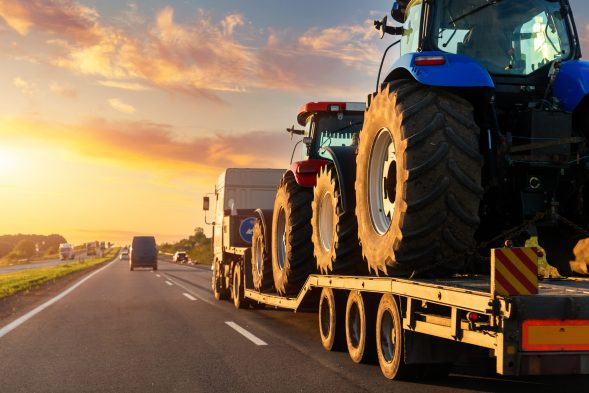4 Emerging Tech Tools for Managing Heavy-Haul Regulations and Compliance
Heavy-haul regulations can be challenging, especially since they vary by state and load size or weight. Fortunately, many companies now offer technology for heavy-hauling compliance. Using it can provide peace of mind and better productivity for logistics professionals. Some solutions can also assist people in learning how to haul heavy equipment while achieving safer outcomes.
1. Mobile Apps Streamline Document Management
Many people have their smartphones in perpetually easy reach these days. Unsurprisingly, many businesses providing technology for heavy-hauling compliance have focused on the app space. Not long ago, the paperwork associated with individual loads was all hard copies, so the risk of losing or misplacing those critical documents always existed. Now, many smartphone apps keep digital versions of paperwork.
That way, drivers or other relevant parties can quickly pull up the necessary data even if something happens to physical copies. These apps also allow users to confirm details or provide proof of delivery — for example, perhaps the information entered into the app by a fleet supervisor doesn’t match the load’s actual size. Drivers or other responsible parties can provide corrective information without concerning themselves with changes to physical documents.
Similarly, drivers or other logistics professionals can report cargo damage through these apps. The ability to provide details immediately after discovering issues is a great way to maintain accountability. Conversely, a driver could use the app to verify they delivered the cargo in excellent condition. If the recipient complains afterward, there’s a digital document trail for future discussions.
2. Artificial Intelligence Makes Heavy-Hauling Compliance Manageable
Some corporate representatives are also exploring how artificial intelligence (AI) could ease people’s compliance-related concerns or requirements. That might mean they offer an AI chatbot users can access 24 hours a day to get quick answers about their situations.
Another possibility is to improve oversight of heavy-haul regulations with automated software that use AI to pull text from printed documents, provide translation help or direct emails to the correct inboxes. Those tools don’t remove the need for human supervision but often allow small or overworked teams to do more with fewer people.
Some of the most ambitious AI applications focus on how to haul heavy equipment with fewer or no drivers. One system handles autonomous merging and lane changes, and can apply the brakes, but people behind the wheel can always override the technology. Training data for the technology also comes from footage occurring 10 seconds before and after an unusual event. That approach familiarizes the AI with uncommon scenarios and makes it work in various traffic patterns.
Although some brands have invested in AI technology for heavy hauling compliance that does not require drivers in the cab, most of those efforts are in the early stages. As AI becomes more widely used and capable in the real world, it’ll be easier for people to learn how to haul heavy equipment while technology assumes significant parts of the task. Such outcomes will help leaders manage heavy-haul regulations regarding hours behind the wheel and rest periods.
3. Smart Sensors Show How to Haul Heavy Equipment Safely
People wishing to buy trailers must consider specifics such as the load’s size and weight before committing to their purchases. It’s also wise to think about user-friendly designs for loading the trailer. Heavy lifting results in approximately 30% of accidents at work, so risk minimization pays off. One option is to choose tilt trailers, which transform the bed into a ramp for easy loading.
However, some decision-makers also purchase trailers with built-in sensors that promote safety throughout fleet companies. Specifics vary by vendors and products, but commonly available offerings can detect poorly secured loads, open doors and other issues that pose safety hazards.
Some versions of this technology for heavy-hauling compliance extend to operator safety, such as sensing an unfastened seatbelt or drowsy person behind the wheel. Those solutions enforce a safety culture throughout an organization, even with its drivers spread throughout the country.
Businesses even have driver bonus programs that reward participants for taking specific actions, such as activating the vehicle’s GPS. Once operators utilize technology and prove they know how to haul heavy equipment safely, they get points redeemable at well-known partner retailers.
Sensors can provide constructive feedback, too. Suppose a driver repeatedly disobeys a company’s safety rules and sensors record the incidents. Then, that employee’s manager has leverage and evidence to use during conversations about the matter. Once the involved parties recognize and agree there’s bad behavior to address, sensors can indicate whether improvement has happened.
4. Cloud Computing Keeps Heavy-Haul Regulations Accessible
Cloud computing has also emerged as an essential technology for heavy-hauling compliance. It’s especially valuable as enterprises grow and expand into other states. Cloud-based platforms eliminate the need for on-site servers and offer features to improve efficiency. Many automatically update, giving people the latest software refreshes to keep their tools current.
Solutions often have project management features, communication capabilities and user-friendly search engines. Then, whether a fleet company operates in one state or worldwide, managers can stay abreast of everything happening at each location and with every team member.
One trucking company that adopted a cloud-first approach did so to stay competitive in a challenging market while adapting to meet customers’ needs. Cloud products allow collecting and referring to data, and tackling operational shortcomings. People could also use them as document repositories for verifying which heavy-haul regulations apply during each part of a load’s journey across the country.
Many cloud products are highly customizable. Logistics professionals interested in using them should begin by considering their needs and looking for suitable possibilities.
Start Improving Hauling Compliance Today
Managing regulations and compliance in the heavy trucking industry isn’t easy. Fortunately, technology offers ample opportunities for process improvements that could boost driver satisfaction and support the bottom line.
Setting a tech budget is a great first step in integrating some of the options described here or elsewhere. People should also consider which operational duties take the most time or have frequent errors. Those may be the best candidates to enhance with technology. In any case, it takes time for employees to learn to do things differently, so being patient and staying motivated about the eventual outcomes will pay off.





Leave a Reply